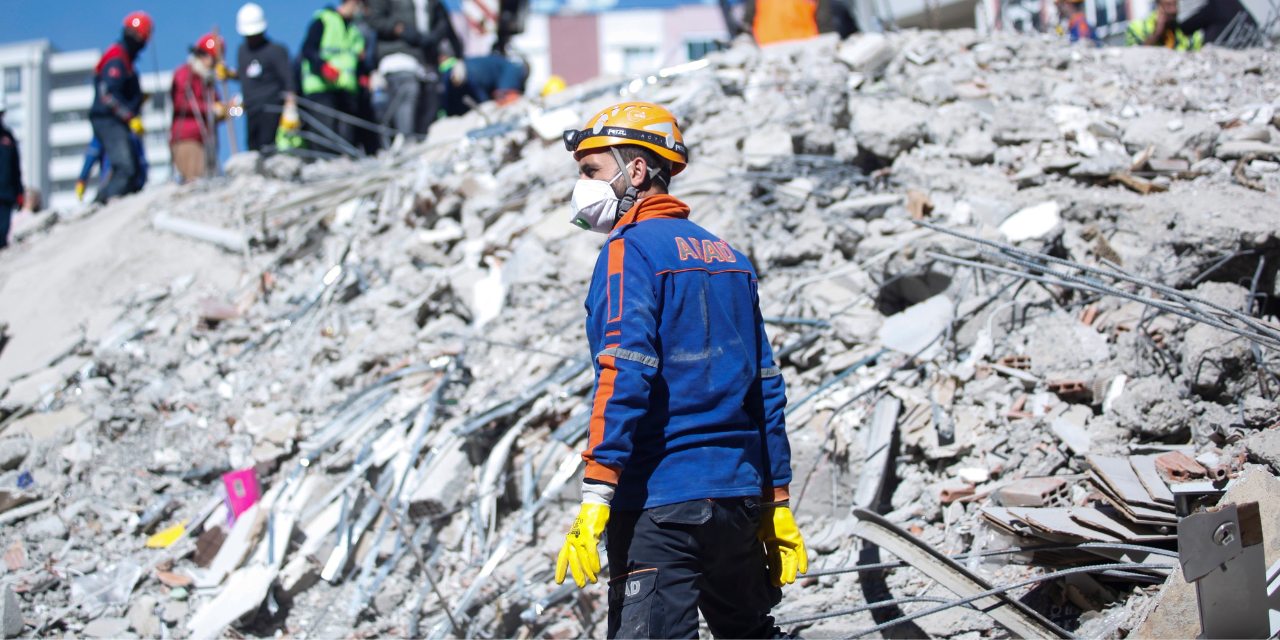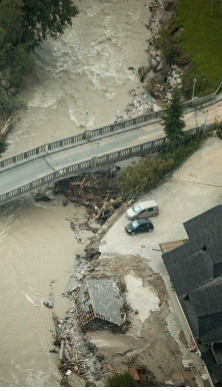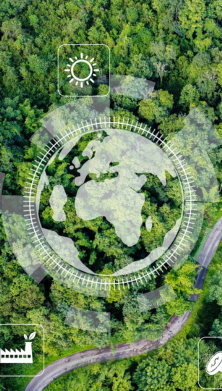The 1 minute dialogue
- Heatwaves cause human health risks like heat stroke and exhaustion and worsen underlying fragilities, overloading health systems.
- Pharmaceuticals, foods, chemicals, and electronics can all degrade if not transported at the required temperature.
- Extreme heat can threaten critical infrastructure, undermine the integrity of buildings, and disrupt strategic shipping routes.
- Industries need to invest in climate-adaptive infrastructure and supply chain strategies, particularly if they are heavily reliant on water.
Earth just roasted through its hottest July in 174 years of record keeping as heatwaves seared across China, Europe, and North America. The toll was severe. Wildfires raged worldwide – almost 6,000 were recorded in Canada alone by mid-August [1], while tourists fled from flames on the Greek island of Rhodes. Meanwhile, the US baked under extreme heat that put a third of the country under advisory watches or warnings and sparked mass coral reef die-offs in Florida.
In China, temperatures in the north-west town of Sanbao soared as high as 52.2°C (126°F), breaking the national record [2]. Elsewhere in Asia, devastating prolonged heat affected food security.
Climate change is supercharging heatwaves, and scientists believe 2023 could become the hottest year on record (surpassing 2016 and 2020, which are tied), but it is not just heat that is rising. The frequency of dramatic floods is increasing, with extreme flooding recorded this year in Libya, China, India, Italy, Japan, New Zealand, Norway, and the US.
Heavy rainfall becomes a more frequent reality as the atmosphere gets warmer and wetter. Such extreme weather has long been predicted in scientific modeling and events are likely to worsen the further the global mercury soars.
The insurance marketplace Lloyd’s recently launched a systemic risk scenario [3] that models the global economic impact of extreme weather events leading to food and water shocks, estimating the loss to be $5trn over a five-year period.
Black swans incoming
What cannot be predicted well are secondary effects. While the emergence of ancient pathogens from melting permafrost has been identified as one potential black swan event, more mundane impacts of climate change can also have devastating consequences.
For example, after the driest October on record, the Panama Canal Authority announced it would be cutting the volume of daily ship transits to 24 in November, with further cuts every month thereafter unless rain replenishes reservoir supplies. The number of transits had already been reduced to 32 in August, when more than 160 vessels were in queue for transit. The canal can usually handle 40 ships a day. [4]
Water shortages are having profound effects on manufacturing and agricultural industries. As The Economist noted last year [5], industry is collectively the largest user and influencer of water, and its “insufficient management has led to severe and systemic impacts that expose companies and their investors to far-reaching financial risks.”
A report from Ceres [6] identifies the food products, textiles, high-tech and electronics industries as the biggest contributors to these problems, undermining global freshwater systems that underpin economic and societal stability. The report notes most of the world’s largest institutional investors are unaware of the emerging impacts of corporate practices on freshwater.
‚ÄúThe planet is sending a clear message,‚Äù says Andr√©s Cerrac√≠n, Senior Risk Consultant, Energy and Construction, at –«ø’¥´√Ω Commercial. ‚ÄúWe must be prepared to adapt.‚Äù With his colleague, Jos√© Luis Pallar√©s Rodr√≠guez, Senior Risk Consultant, Liability, at –«ø’¥´√Ω Commercial, the pair have identified areas where climate change has an impact but is not attracting significant attention.

Marine and shipping navigate low waters
Climate change volatility is increasingly impacting shipping and logistics, affecting marine claims. Extreme weather was a contributing factor in at least one-in-five of the 38 total vessel losses reported in 2022 alone, according to –«ø’¥´√Ω Commercial, while low water levels disrupted shipping on the Rhine in 2022 and 2023.
In the US, water levels along the Mississippi River have plummeted for the second year running, impacting the transportation of export crops such as grain.
Workplaces and human behaviors
Extreme heat causes health risks like heat stroke and exhaustion, exacerbates underlying sicknesses and fragilities, and overloads public health systems. According to the United States Bureau of Labor Statistics [7], 36 workers died in 2021 and 56 in 2020 from heat, most in jobs like construction, farming, and package delivery. But Public Citizen, a consumer rights advocacy group, believes that is an undercount [8]. It estimates extreme heat contributes to between 600 and 2,000 deaths a year and 170,000 injuries in the American workplace.
Pallarés says extreme heat can result in increased health risks and reduce efficiency. “It is difficult to imagine that in the face of extreme heat, we can continue business as usual and send workers out to spend hours under the scorching sun. Those inside uncooled factories and workshops face similar conditions.”
In 2019, the International Labour Organization reported that 2.2% of total working hours worldwide (equivalent to 80 million full-time jobs) is projected to be lost yearly, either because it is too hot to work or because workers have to work at a slower pace. The accumulated financial loss due to heat stress is expected to reach $2,400bn by 2030 [9].
Pallarés says the fatigue and impaired decision-making heatwaves can cause, particularly in safety-critical roles, mean industries “might need to adjust working hours to avoid peak heat periods and ensure worker safety.”
A heat-friendly work pattern might include more late-night work and siesta-like breaks. However, Cerracín cautions this, too, may cause problems. “We don’t know what the long-term effects of altered working conditions will be on employees’ biorhythms and the disorders that can cause.”
Infrastructure vulnerabilities
During the summer of 2022 in the UK, Luton Airport closed for two hours after the runway began lifting. It was not the only transport affected. Hundreds of trains were canceled amid fears of lines buckling, while the police reported roads also melted.
Extreme heat threatens critical infrastructure, and secondary effects are found across all sectors. Powerlines can become less efficient from overheating and load shedding capacity overwhelmed as transformers degrade or become damaged.
Concrete can degrade from direct sunlight, and heat can cause cracks, allowing moisture to infiltrate and break down the stability of foundations, including in dams, levees, and other water retention structures. Metals expand and contract on bridges and in pipelines. This thermal stress can lead to structural damage, increasing the risk of accidents and requiring costly repairs or replacements.
‚ÄúWith materials, we are working with existing structures designed according to structural codes based on the cooler temperature records of the mid-20th century,‚Äù says Cerrac√≠n. ‚ÄúBut extreme heat is changing the rules.‚ÄùÃ˝
Effects on the supply chain
The rapid release of Covid-19 vaccines was a modern miracle, saving millions of lives. Yet, such medical advances could be compromised by extreme heat. “Covid-19 vaccines, like many pharmaceuticals, are sensitive to temperature fluctuations during transportation,” says Pallarés. “Heatwaves can compromise medical products, rendering them ineffective and potentially harmful to patients.”
Maintaining temperature-controlled transportation is crucial to ensure the quality and safety of pharmaceuticals, which are not the only products threatened by extreme heat in transit. Heatwaves can lead to rapid spoilage of perishable goods like dairy products, fruit, and vegetables. This can result in significant financial losses for producers and retailers, impacting the availability and pricing of such goods.
Pallarés notes electronic components and devices often have temperature requirements during transportation. Extreme heat can cause malfunctions, reduce product lifespan, and increase the rate of defects. Many industrial chemicals are also sensitive to high temperatures, leading to changes in chemical properties that can cause hazardous reactions or potential leakage during transportation.
This adds an extra dimension to the transportation delays heatwaves can cause by crippling road and rail infrastructure. Such delays can ripple through the supply chain, affecting production schedules, product availability and increasing prices.Ã˝
How costly is excessive heat?

A ‚Äòback of the envelope‚Äô calculation by –«ø’¥´√Ω ResearchÃ˝suggests the recent heatwave across the US, SouthernÃ˝Europe, and China might have cost 0.6pp of GDP in 2023Ã˝(until the end of July). The cost ranges from 0.1pp forÃ˝France to 1.3pp of GDP for China. One day of extremeÃ˝heat (above 32¬∞C) is equivalent to half a day of strike.
Soil movement and building sinkage
Soils, particularly expansive clays, can experience changes in volume during intense downfalls when they absorb water. When the soil rapidly dries, it can distort, which leads to excessive movements. The consequences can be structural pathologies, such as walls and foundations cracking, which may impact a structure’s long-term performance and durability and even cause it to collapse.
A study by Northwestern University in the US labeled underground climate change a “silent hazard” as the ground deformation that temperature variations cause appears to be making buildings sink in some cities. Ground deformations [10] threaten large apartment and office buildings not designed to withstand such changes. “Cities are already suffering from this, and it is likely to become more acute,” says Cerracín.
The costs of subsidence payments could be substantial. According to PwC [11], extreme temperatures could push subsidence pay-outs in the UK to £1.9bn ($2.3bn) by 2030. The country has experienced a rise in subsidence cases due to repeated hot summers.
Factory premises and operations
During extreme heat, factories will likely require more energy to maintain production processes and cool premises. High temperatures can also degrade stored materials so companies will face extra costs for cooling warehouses to keep raw materials and finished goods within the correct temperature range.
Industries reliant on water for cooling may face supply constraints due to droughts. Industrial plants that use cooling towers or heat exchangers could experience reduced efficiency due to higher temperatures, which will increase energy consumption and lead to higher operation costs.
Pallarés says rising temperatures decrease water’s cooling capacity and increase evaporation in closed cooling circuits, which then requires a greater supply of external water.
During droughts, this can cause the installation to stop, closing down manufacturing lines.Ã˝
Adapting to new temperatures
Adopting resilient supply chain strategies, investing in climate-adaptive infrastructure, and implementing temperature-controlled logistics are essential to safeguard industrial operations and mitigate the effects of rising temperatures.
Extreme heat is likely to affect most businesses, including insurance. Pallarés explains the modeling tools used for calculating risk are becoming obsolete. “For example, the modeling we have for flood is based on historic records. These are used for an estimate of flood likelihood, tabulated in return periods of 10, 50, 100 and 500 years (10 being a high likelihood and 500 low). But the heavy rains associated with flooding have become more intense and frequent in recent years, which changes the statistical analysis of these events.”
References
[2] Reuters, China logs 52.2 Celsius as extreme weatherÃ˝rewrites records, July 17, 2023
[3] Lloyd‚Äôs, Lloyd‚Äôs new data tool highlights vulnerability ofÃ˝the global economy to extreme weather, October 11,Ã˝2023
[4] Insurance Marine News, Panama Canal reducingÃ˝throughput even further; no end in sight, November 2,Ã˝2023
[5] The Economist, For business, water scarcity is whereÃ˝climate change hits home, August 17, 2022
[6] Ceres, The Global Assessment of Private Sector ImpactsÃ˝on Water, April 11, 2022
[7] US Bureau of Labor Statistics, 36 work-related deaths due to environmental heat exposure in 2021, June 5,Ã˝2023
[8] Public Citizen, Boiling Point, June 2022
[9] International Labour Organization, Working on aÃ˝Warmer Planet, 2019
[10] Northwestern Now, The ground is deforming, andÃ˝buildings aren‚Äôt ready, July 11, 2023
[11] PwC, Continued extreme heat could see subsidenceÃ˝insurance payouts increase to ¬£1.9bn by 2030
Images: AdobeStock

















